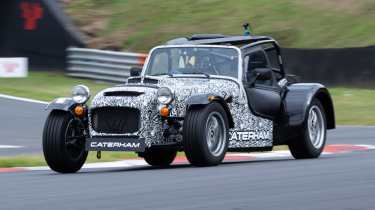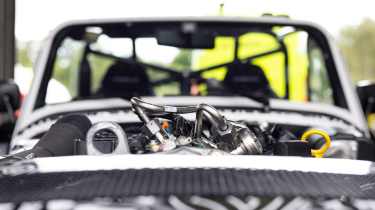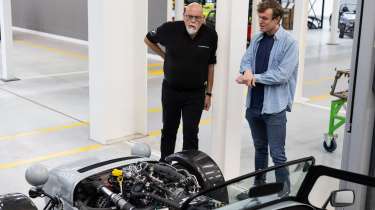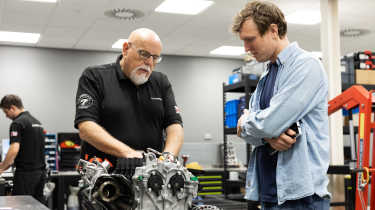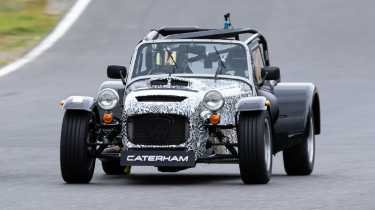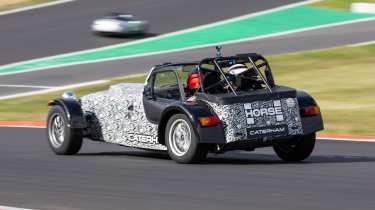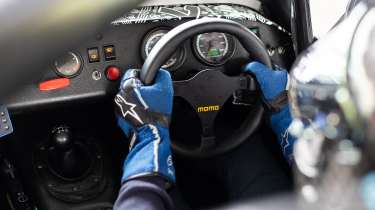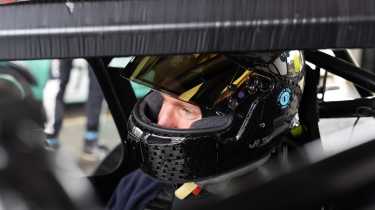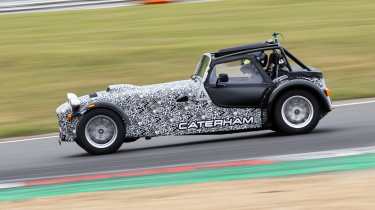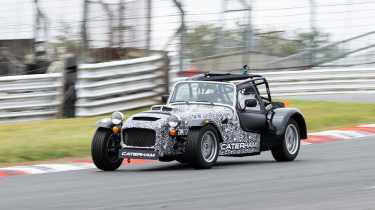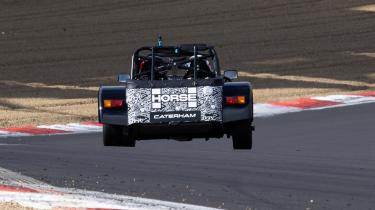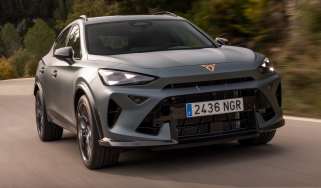Caterham Horse prototype review – new turbo engine keeps the Seven alive
Caterham needs a replacement for Ford’s out-of-production Sigma engine. Its solution is a 1.3 turbo from Horse. We drive it
This car is powered by the engine that could safeguard the Caterham Seven’s future. The conundrum facing Caterham is that the 1.6-litre Ford Sigma engine – which has powered plenty of Seven road and race models over the years – ended production several years ago. Caterham’s been constructing Sigma engines from new spare parts in the interim, but a permanent replacement is needed.
And this is it: a 1.3-litre, turbocharged in-line four-cylinder engine from a business called Horse Powertrain, with manufacturing capacity across 17 plants, and five R&D centres, across three continents, with its headquarters in the UK.
> My Life & Cars – Jez Coates, ex-Caterham technical director and vehicle engineer
The car pictured here is a prototype, an Academy race car fitted with the new Horse engine, new gearbox and new differential – more on which later. We’ve been to the Caterham factory to see the new engine up close with Caterham CEO Bob Laishley, and then to nearby Brands Hatch circuit to test the prototype.
Caterham’s new engine in detail
The particular engine selected by Caterham is called the HR13DDT, with a complicated history of owners prior to the formation of Horse Powertrain in spring 2024 (following its previous guise as Horse Technologies, a subsidiary of Renault).
More reviews
Group tests
- Ariel Atom 4R v Caterham Seven ‘evo25’: power-to-weight heroes go head-to-head
- Caterham Super Seven 600 v Super Seven 2000
Long term tests
- Caterham Seven evo25 Fast Fleet test – living with a track car for the road
- Caterham Seven evo Edition revealed – bespoke 420R joins the Fast Fleet
Reviews
The engine was originally created as part of the prior alliance between Nissan, Daimler and Renault, and variants have appeared in cars such as the Renault Clio, Nissan Qashqai and Mercedes A-Class, with power outputs of 110, 130 and 160 horsepower. It’s also seen motorsport action, being raced in spec Renault Clios in France. Caterham has opted for the 130bhp version for the Academy car. It’s built in large volumes at a plant in Valladolid, Spain. Horse plans to keep building the engines more than 10 years from now.
Caterham CEO Bob Laishley is familiar with the engine from his time at Nissan, although that’s not the primary reason for its selection. He explains it’s been a long process for Caterham to find a suitable engine, examining eight different power units from five different manufacturers.
A big part of the challenge was quite simply finding an engine that fits the confines of the Seven’s engine bay, and within its bonnet line. Modern engines are getting taller, Laishley explains, and the height above the crank is a packaging challenge for the Seven.
We’re introduced to the engine on a stand in Caterham’s impressive 54,000 sq ft factory, which has been the company’s HQ since 2023. The aluminium-block, twin overhead-cam HR13DDT engine has numerous ticks in the pro column; proven reliability, mass-produced quality and features such as metal-sprayed bore liners (as per the Nissan GT-R), for example.
‘There is one con,’ Laishley explains. Although less so than some contemporary engines, the HR13 is taller than the Sigma and the topmost part of the engine – specifically the 300 bar high-pressure fuel lines and pump – sit above the Seven’s bonnet line.
Since these components have been manufactured in the millions and are extremely reliable, Caterham has understandably decided against designing and manufacturing replacements (and their additional associated tooling costs and complications). It therefore needs to design a bonnet scoop or power bulge to accommodate the lines, which look a little like strands of a tousled hairdo at the top of the engine. This prototype has a temporary, angular bonnet vent fabrication; various more elegant-looking solutions are currently being designed and evaluated.
The HR13DDT is a lot lighter than the Duratec, although the additional plumbing and cooling measures required for the turbo add a bit of weight back on. Overall kerb weight for the Horse-powered Academy car is roughly the same as that of the Sigma-powered equivalent.
Caterham installs its own lightweight flywheel, and has also redesigned the manifold and exhaust system in order to reposition the catalytic converter – not least because it initially sat directly in the path of the steering column for right-hand-drive cars. (For that reason, the first mule car was a left-hand drive, wider SV chassis model.)
The standard wet sump is unchanged. Caterham has also created its own ECU. Horse Powertrain representatives say they’ve been impressed at just how quickly the little Dartford sports car company had the ECU ready and the engine installed and running in a car; small companies with a motorsport background make much faster progress than big corporations. Otherwise, it’s in Caterham’s interest to keep the engine mechanicals as standard as possible, to reduce cost for its end customers.
The new engine may face one further challenge: negative perception from those who associate the Seven with naturally aspirated engines first and foremost. This most evergreen of sports cars has been powered by all kinds of engines over the years, of course, but the concept of a turbocharged version outside of the little three-cylinder 660cc Suzuki turbo used in the Caterham Seven 170 is something of a new concept.
‘This transition [from naturally aspirated to turbocharged] has in the past been met with scepticism,’ Laishley tells evo, ‘but suitable, affordable naturally aspirated engines for this application are unicorns – they don’t exist.’
Not only a new engine – a new gearbox and differential
It’s not just a new engine the Seven needs. ‘This is the first time in Caterham’s history we’ve had to redesign for an engine, gearbox and differential at the same time,’ Laishley says. ‘It’s always been one at a time in the past.’ However, the current situation is something of a perfect storm.
Current Caterhams use the five-speed gearbox from older Mazda MX-5s, and differentials from the previous-generation BMW 1-series. Mazda hasn’t manufactured the five-speed gearbox for some time, and although BMW agreed to continue to extend the diff’s manufacturing run for Caterham, that too must now come to an end.
Finding a suitable gearbox was a challenge and Caterham has settled upon using the six-speed gearbox from the current Mazda MX-5. It looked at others but they would have required modifying the Seven’s chassis – a compound complication Caterham is keen to avoid.
Caterham likewise explored 10 different suppliers for the differential but settled on a bespoke design, a considerable investment. It’s lighter than the old BMW unit, with improved isolation. The prototype we’re testing is a development with the new diff inside the old casing; the next prototype, currently in-build, incorporates the new unit as a whole.
Driving the new Caterham engine
Will a four-cylinder turbo engine feel out of place in a Seven? There’s one way to find out. As I settle into the prototype (complete with tongue-in-cheek graphic ‘disguise’ – it could only be a Seven, but it’s a canny bit of advertising) and pull into the pitlane at Brands Hatch, the Horse engine quickly feels a natural fit for the car.
It idles smoothly and unobtrusively, and it’s easy as pie to pull away, the low kerb weight allowing the engine to take the car out of the garage smoothly with barely a brush of the throttle pedal.
During the first couple of laps, I find myself running into the 6600rpm rev limiter a couple of times, since revs pick up so strongly yet undramatically. It doesn’t take long to reach the redline. I find myself relying on the red shift-up light thereafter, partly because the engine is relatively quiet with a full-face helmet on and race-pace wind noise.
Whereas in Sigma and Duratec-engined Sevens you might leave the shift light illuminated for a few fractions of a second, eking out every last rev, with the Horse engine you need to shift up almost as soon as you see it, cresting the wave of torque. As always when lapping on track, your gearchanges eventually become second nature, and before too long you’ll find yourself shifting instinctively without relying totally on the instruments.
The Sigma engine developed 125bhp, and the Horse engine is comparable with 130bhp. The HR13DDT offers a great deal more mid-range torque than the Sigma, however. As a result, you take the corners a gear higher than you might in a Sigma-engined car (Paddock Hill is taken in fifth, for example).
Delivery of both power and torque is incredibly linear. In fact, the engine doesn’t feel particularly turbocharged, at least not in such a lightweight car. There is a scant sliver of lag to drive around out of slow corners, which you need to get on the throttle slightly early to counteract, but it’s very subtle.
And the power and torque delivery is smooth and precise enough to allow you to feed the throttle in precisely. Studying the power and torque curves on a graph, they really are linear in the truest sense: the power curve is an almost perfect diagonal line, and the torque curve a flat tabletop from 2000rpm.
The new diff works very well. Caterham has deliberately avoided too aggressive a pre-load, and despite having plenty of torque available at all revs, it never overwhelms the rear tyres. As with the existing Caterham Academy car, the prototype is on 185/60 13-inch Toyo Proxes CF2 road tyres: chosen for the affordability, longevity (one set can last a season), and mixture of low-ish grip (by racing standards) but safe balance for predictable handling, giving beginners a good platform to refine their car control.
It’s easy to pick up a bit of understeer if you spend too much time off-throttle in the long Clearways/Clark Curve right-hander but you quickly adapt to it. There are lots of cars on track at Brands – this test takes place during an open trackday – but the little Caterham laps quicker than most of them and spends much more time overtaking than being overtaken.
During Caterham’s testing, the Horse-engined car has lapped quicker than the existing Sigma-engined Academy lap record, so it is a little faster pound-for-pound but the level of performance feels perfect for the car. It feels a right-sized balance of power and torque to grip, for beginners to get their head around and for experienced drivers to enjoy.
The revs respond well enough to heel and toe slickly on downshifts, and the six-speed Mazda gearbox feels a good match for the car. Coincidentally, I drove to Brands Hatch in evo’s long-term-test Mazda MX-5, in which the same gearbox feels joyously slick. In the prototype Caterham, the shift demands a little more patience and doesn’t like to be rushed – but that’s a function of the new transmission’s housing being adapted to fit the prototype. The final production version should feel just as sweet as the Mazda.
Caterham hasn’t yet encountered any cooling issues (and a brutal endurance test at the Millbrook Bowl is lined up soon to make sure). I can feel the transmission tunnel getting warm during the test, but no more so than previous Caterhams I’ve driven on track (and far less than the 420R race car we experienced in the literal heat of battle at Donington Park in 2023, though that was during extremely hot weather).
Downsides? It’s not the most charismatic of engines – certainly not in terms of sound, which, subjectively, I’d say is a little forgettable, on the track at least. But that’s okay – you don’t necessarily buy a Seven for the sake of its engine. The Duratec, for example, is very effective but not necessarily the most characterful engine in the world.
The important thing is how how the Seven as a whole feels, and the magic is still as strong as ever. Perhaps the best compliment I can pay the new engine is that, after a few laps, I begin to forget about the powerplant and just concentrate on the handling, the cornering, the experience as a whole – all of the things that make the Seven special.
Some may feel a turbo engine doesn’t feel right for a Caterham, and although it’s a little while since I’ve driven a Sigma-engined Seven, from memory I prefer the zinginess of the engine’s little-low-down, all-at-the-top nature at the redline. But suitable mainstream atmospheric engines simply no longer exist.
And the Horse engine can offer much more useable torque than the Sigma, and such a sweetly linear delivery that it doesn’t feel a square peg for a round hole. Its powerband is much more useable than the characterful but narrow 660cc Suzuki turbo engine, for example, and it feels a very good fit for the Seven overall.
As always, experiencing an engine on track, where you’re constantly in the sweet spot of its power band and using full throttle as much as possible, is one thing and driving on the road is quite another. But on the basis of this first encounter, the new Horse unit suits the Seven very well indeed. It’s still a magical sports car, and the new power unit should ensure it stays that way for the foreseeable future.
Debut for the new engine: Caterham Academy race series
Aside from the last-of-the line Seven 310 Encore, the only current Seven to be powered by the Sigma engine is the Academy race car.
The Caterham Academy championship is the natural entry point to Caterham racing, open only to novice drivers who have never competed in car racing before. An all-inclusive package, it bundles the Academy car (which is road-legal, as well as race-prepared), entry fees to the championship, a training package for drivers to gain their race licence, and technical support.
Caterham estimates more than 1400 drivers have gained their race licence since the Academy’s inception in 1995. Longtime evo readers may remember the ‘Race Academy: The Rivals’ series of features in the magazine, where Jethro Bovingdon and David Yu both competed in the 2003 Academy season.
The Academy is an important asset to the Caterham brand, not least because it gets people onto the Caterham motorsport ladder and gives them a chance for them to stay within it. After their Academy season, drivers can graduate into the Caterham Roadsport series using the same car, or upgrade to the serious 420R championship car.
And it’s the Academy into which the Horse engine is first being applied. This 2025 Academy season will be the last to use the Sigma engine, and Caterham will have a full grid of 34 Horse-engined cars for 2026. Price for the full Academy package, including the car, is currently £42,995. Laishley explains that two Academy seasons are the equivalent of around 5000 miles; and that’s what Caterham’s development team are aiming to put on this prototype car (soon to be joined by a second prototype, currently in-build) before customers take delivery.
Caterham won’t state its plans for the Horse engine beyond the Academy but since it has signed a multi-year supply deal for the engine, and the 2-litre naturally aspirated Ford Duratec engine used in other Seven models in differing power outputs is also now out of production, it’s reasonable to expect that the Horse engine may also replace the Duratec in due course, perhaps in 160bhp form.
Or a higher output; Horse says the engine is very tuneable. For now Caterham has a stockpile of Duratec engines it can call upon for the interim future. Caterham’s deal with Suzuki for the 660cc Seven 170 and Super Seven 600 continues unchanged.
